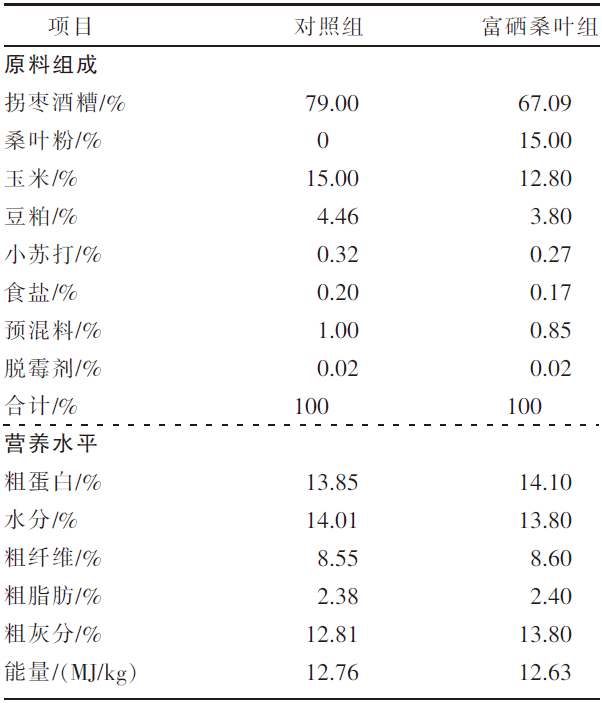| [1] |
童建军, 原积友, 安宁. 《陕南白山羊》(DB61/T 1003—2015)解读[J]. 畜牧兽医杂志, 2017, 36(5):102-103,105.
|
| [2] |
程开平. 陕南白山羊品种资源保护与发展利用[J]. 畜牧兽医杂志, 2020, 39(3):29-31.
|
| [3] |
HASSAN F U, ARSHAD M A, LI M W, et al. Potential of mulberry leaf biomass and its flavonoids to improve production and health in ruminants: Mechanistic insights and prospects[J]. Animals, 2020, 10(11):2076.
doi: 10.3390/ani10112076
|
| [4] |
侯启瑞, 谢辉, 戎世芳, 等. 桑叶通过影响瘤胃微生物区系调控湖羊脂肪沉积[J]. 江苏科技大学学报(自然科学版), 2021, 35(4):89-95.
|
| [5] |
刘自新, 李如冲, 梅宁安, 等. 桑饲料对宁夏滩羊屠宰性能及肉质理化指标的影响[J]. 黑龙江畜牧兽医, 2011(7):76-78.
|
| [6] |
张建明, 柳立新, 曹亮, 等. 蛋白桑对奶山羊生长性能影响的研究[J]. 畜牧兽医杂志, 2018, 37(1):4-5.
|
| [7] |
陶璐璐, 侯启瑞, 戎世芳, 等. 日粮中添加桑叶粉对湖羊生长性能、血液生化指标、屠宰性能及肉品质的影响[J]. 蚕业科学, 2020, 46(1):105-111.
|
| [8] |
楚渠, 彭云武. 安康两种野生桑的营养分析[J]. 陕西农业科学, 2012, 58(2):104-105.
|
| [9] |
彭云武, 王荣辉, 楚渠, 等. 9个桑树品种的硒、类黄酮、1-DNJ含量的分析[J]. 陕西农业科学, 2021, 67(9):11-14.
|
| [10] |
杨金宏, 彭云武, 陈正余, 等. 安康地区桑叶主要功能物质的含量与抗氧化活性[J]. 贵州农业科学, 2020, 48(9):33-36.
|
| [11] |
罗海玲, 王朕朕. 从脂肪酸构成角度谈优质羊肉生产[C]// 2013中国羊业进展. 北京: 《当代畜牧》杂志社, 2013:252-255.
|
| [12] |
MA T, CHEN D D, TU Y, et al. Dietary supplementation with mulberry leaf flavonoids inhibits methanogenesis in sheep[J]. Animal Science Journal, 2017, 88(1):72-78.
doi: 10.1111/asj.12556
pmid: 27112278
|
| [13] |
VENKATESHKUMAR R, GAUTAM C, SHOBHA N, et al. Use of mulberry leaves as supplementary food in cow and goat to improve milk production[J]. International Journal of Applied Research, 2015, 1:81-84.
|
| [14] |
李伟玲. 桑叶对肉羊生产性能、血液生化指标、免疫抗氧化功能和肉品质的影响[D]. 呼和浩特: 内蒙古农业大学, 2012.
|
| [15] |
SUN H, LUO Y, ZHAO F F, et al. The effect of replacing wildrye hay with mulberry leaves on the growth performance, blood metabolites, and carcass characteristics of sheep[J]. Animals, 2020, 10(11):2018.
doi: 10.3390/ani10112018
|
| [16] |
寇宇斐. 饲料桑的营养动态及其对育肥湖羊生产性能的影响[D]. 兰州: 兰州大学, 2021.
|
| [17] |
侯丽萍, 刘克礼, 赵祥民, 等. 湖羊与杜湖杂种羔羊生产性能和肉品质对比研究[J]. 畜牧兽医杂志, 2021, 40(4):1-4,8.
|
| [18] |
江炎庭, 李卫娟, 洪琼花. 云上黑山羊成年母羊屠宰性能及其相关性分析[J]. 中国草食动物科学, 2021, 41(5):42-44,78.
|
| [19] |
周鹏, 蒋婧, 黄勇富, 等. 酉州乌羊、白山羊和波杂羊的屠宰性能及肉品质研究[J]. 西南大学学报(自然科学版), 2017, 39(1):9-15.
|
| [20] |
古扎力孜克·肉孜, 王文静, 王伟华. 新疆南疆不同品种绵羊肉品质的比较[J]. 塔里木大学学报, 2018, 30(2):47-58.
|
| [21] |
张玉伟, 罗海玲, 贾慧娜, 等. 肌肉系水力的影响因素及其可能机制[J]. 动物营养学报, 2012, 24(8):1389-1396.
doi: 10.3969/j.issn.1006-267x.2012.08.001
|
| [22] |
吴非凡, 茆建昱, 丁洛阳, 等. 影响羊肉pH变化的因素及其糖原代谢通路机制的研究进展[J]. 动物营养学报, 2020, 32(2):571-577.
doi: 10.3969/j.issn.1006-267x.2020.02.012
|
| [23] |
马晓冰, 苏琳, 林在琼, 等. 不同品种肉羊肌肉的糖酵解潜力及其与肉品质的相关性[J]. 食品科学, 2015, 36(15):1-4.
doi: 10.7506/spkx1002-6630-201515001
|
| [24] |
魏琳琳, 孙建云, 张东城, 等. γ-亚麻酸毒理学安全性评价[J]. 毒理学杂志, 2017, 31(3):241-244.
|
| [25] |
RUSSO G L. Dietary n-6 and n-3 polyunsaturated fatty acids:From biochemistry to clinical implications in cardiovascular prevention[J]. Biochemical Pharmacology, 2009, 77(6):937-946.
doi: 10.1016/j.bcp.2008.10.020
|
| [26] |
WEBB E C, O′NEILL H A. The animal fat paradox and meat quality[J]. Meat Science, 2008, 80(1):28-36.
doi: 10.1016/j.meatsci.2008.05.029
pmid: 22063167
|
| [27] |
YOUSEFI A R, KOHRAM H, ZARE SHAHNEH A, et al. Comparison of the meat quality and fatty acid composition of traditional fat-tailed (Chall) and tailed (Zel) Iranian sheep breeds[J]. Meat Science, 2012, 92(4):417-422.
doi: 10.1016/j.meatsci.2012.05.004
pmid: 22652069
|
| [28] |
DINH Q T, CUI Z W, HUANG J, et al. Selenium distribution in the Chinese environment and its relationship with human health:A review[J]. Environment International, 2018, 112:294-309.
doi: 10.1016/j.envint.2017.12.035
|
| [29] |
王浩东, 张建东, 谢娟平, 等. 安康地区土壤硒资源分布规律研究[J]. 安康学院学报, 2013, 25(6):8-11.
|




